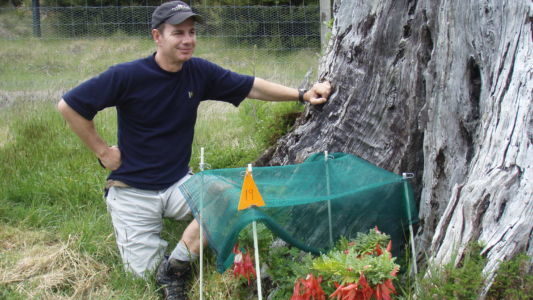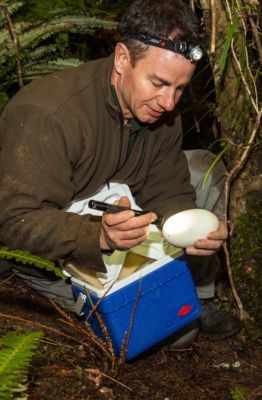Guest blog by Peter Heath
It’s dead. Very dead, judging by the stench and the smooshed appearance of the remains – all fur, bones and black-brown gloopy stuff. A possum, maybe? A rabbit?

“It’s not just townies,” Simon says, smiling at my obvious disgust. “There’s plenty of debate among farmers and bush dwellers, too. One thing’s for sure, though, if it’s going to be successful it has to be done properly. Scientifically. No half measures.”
Turns out it was a stoat. By “debate” Simon Hall was referring to the arguments raging across New Zealand about the best ways to deal with the many pests invading our wild places. And by “properly” and “scientifically” he was talking about the way it’s done on the four properties owned by the Forest Lifeforce Restoration Trust; three on the North Island and one in Fiordland.

Simon established the Trust in 2006. It’s funded indirectly by his company, food manufacturer Tasti Products, and exists to restore threatened species of fauna and flora to native forests. But the list of pests doing their best to thwart it is long. And, to this townie, surprising. You see, we all know about the hordes of possums digesting our forests one tree at a time. But goats? Who knew goats were among the prime culprits browsing our gloriously-flowered Kakabeak to the brink of extinction?
And of course we all know what those cunning, slinky, evil-eyed stoats do to young kiwi. But cats? Apparently feral cats are a real problem out in the back of beyond. Families in urban centres across the land may be comforted by the thought that their missing moggies might be making whoopee way out in the wild. But to Simon and the Forest Lifeforce Restoration Trust team these murderous miscreants mean mayhem.
Ferrets, weasels and rats are also on the list, as are wilding pines, gorse, pampas and buddleia. Incidentally, do you know how to tell the difference between pampas and the remarkably similar indigenous toetoe? The pampas’ compact plume sticks up, apparently, while the toetoe plume is typically more raggedy and flag-like, and hangs down.
“Exotic plants are as much a pest as animals,” Simon insists. “Most of our native forests have had the soul ripped out of them through years of mismanagement and commercial exploitation, now the indigenous plants that remain have to compete with these hardy interlopers for space, light and nourishment. It’s vital that we combat these plant pests with the same ruthlessness as we do the animals.”
The Forest Lifeforce Restoration Trust is engaged in eight primary conservation projects, each of which complements the others. The reduction and elimination of predator populations is a vital part of the overall drive to provide a safe place for a variety of native plant and bird species to re-establish viable or healthy populations.
In addition to Kiwi, the birds the Trust aims to protect include the threatened Whio (Blue Duck), Kaka, Yellow-Crowned Kakariki, Long-Tailed and Shining Cuckoos, and Kereru. Discussions are currently underway about adding Kokako to that group.
Plants on their ‘must save’ list include the flamboyant Kakabeak (Clianthus maximus) and Turner’s kohuhu (Pittosporum turneri), both of which are classified as ‘Nationally Critical’ – the Department of Conservation’s highest threatened plant ranking. The list also features several species of rare mistletoe and the Dactylanthus (Dactylanthus taylorii), New Zealand’s only indigenous fully parasitic flowering plant. This is known rather prosaically in te reo as pua o te Reinga, ‘flower of the underworld’.
For all this to happen it’s essential that predator populations are at least reduced, or preferably eliminated.
Possums, stoats, ferrets and weasels are controlled with the help of the Animal Health Board through the aerial application of cereal baits containing 1080 poison and coated with deer repellent. This is largely the source of the “debate” Simon speaks about.
“When we first established the Trust I was very sceptical about the desirability of using 1080,” he said. “We allowed its use in a trial capacity and the difference it made to the survival rates of our young kiwi and whio populations was immense and relatively immediate. Now we allow widespread use of 1080 on our properties and we’re grateful for the boost it gives to our efforts.”
But it’s not all about poison. Goats and cats are shot by contractors and the Trust runs an extensive trapping operation with the support of the Department of Conservation (DOC), which provides about half of the traps.
Neither is it all about kiwi. One of the results of the Trust’s work on predator control is that the population of Blue Duck, or whio, on the Trust’s property in the Maungataniwha Native Forest has soared, prompting DOC’s Whio Recovery Group to classify it as a ‘Recovery Site’.
The pest eradication programme is meticulously recorded, from the number of wilding pines and goats dispatched on each of the Trust’s properties right down to the percentage-based ‘tracking index’ of rats in a 600 hectare sanctuary at Maungataniwha, heavily laced with traps and poisoned baits. Peaks and troughs in the number of pests recorded on a monthly basis are correlated with 1080 drops, trap expansion programmes and other eradication initiatives, and the observations shared with DOC, Hawke’s Bay Regional Council and other organisations the Forest Lifeforce Restoration Trust has partnered with in the fight to save our indigenous heritage.
This is what Simon means when he talks about doing it properly, with no half measures.
It’s true public private partnership in wildlife conservation, in action. It’s not often any of us gets to meet individual New Zealanders who can match government funding, dollar for dollar, to make good things happen in our wilderness. So it’s nice when I do.
Even if he is waving a dead stoat in my face.

